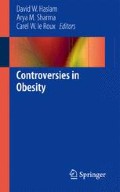Abstract
With a very good reason, obesity is said to be a complex and heterogeneous trait. Its genetics are extremely cumbersome, its environmental etiology multifaceted, and the interactions of these, mediated in part by the epigenetics, are enormously complicated. Further, the consequences of obesity vary, sometimes following and sometimes dissociating from the degree of overweight. A proportion of obese individuals even remain free of metabolical complications. This phenomenon, too, may be genetic, environmental, epigenetic, or all of the three.
Access this chapter
Tax calculation will be finalised at checkout
Purchases are for personal use only
References
Stunkard AJ, Foch TT, Hrubec Z. A twin study of human obesity. JAMA. 1986;256:51–4.
Allison DB, Kaprio J, Korkeila M, Koskenvuo M, Neale MC, Hayakawa K. The heritability of body mass index among an international sample of monozygotic twins reared apart. Int J Obes Relat Metab Disord. 1996;20(6):501–6.
Stunkard AJ, Sørensen TIA, Hanis C, Teasdale TW, Chakraborty R, Schull WJ, et al. An adoption study of human obesity. N Engl J Med. 1986;314:193–8.
Rokholm B, Silventoinen K, Tynelius P, Gamborg M, Sørensen TI, Rasmussen F. Increasing genetic variance of body mass index during the Swedish obesity epidemic. PLoS One. 2011;6(11):e27135.
Mustelin L, Silventoinen K, Pietiläinen KH, Rissanen A, Kaprio J. Physical activity reduces the influence of genetic effects on BMI and waist circumference: a study in young adult twins. Int J Obes. 2009;33:29–36.
Li S, Zhao JH, Luan J, Ekelund U, Luben RN, Khaw KT, et al. Physical activity attenuates the genetic predisposition to obesity in 20,000 men and women from EPIC-Norfolk prospective population study. PLoS Med. 2010;7:pii: e1000332.
Kilpeläinen TO, Qi L, Brage S, Sharp SJ, Sonestedt E, Demerath E, et al. Physical activity attenuates the influence of FTO variants on obesity risk: a meta-analysis of 218,166 adults and 19,268 children. PLoS Med. 2011;8:e1001116.
Loos RJ. Genetic determinants of obesity and their value in prediction. Best Pract Res Clin Endocrinol Metab. 2012;26:211–22.
Author information
Authors and Affiliations
Corresponding author
Editor information
Editors and Affiliations
Rights and permissions
Copyright information
© 2014 Springer-Verlag London
About this chapter
Cite this chapter
Pietiläinen, K.H. (2014). Genetics and Epigenetics: Myths or Facts?. In: Haslam, D., Sharma, A., le Roux, C. (eds) Controversies in Obesity. Springer, London. https://doi.org/10.1007/978-1-4471-2834-2_13
Download citation
DOI: https://doi.org/10.1007/978-1-4471-2834-2_13
Published:
Publisher Name: Springer, London
Print ISBN: 978-1-4471-2833-5
Online ISBN: 978-1-4471-2834-2
eBook Packages: MedicineMedicine (R0)

